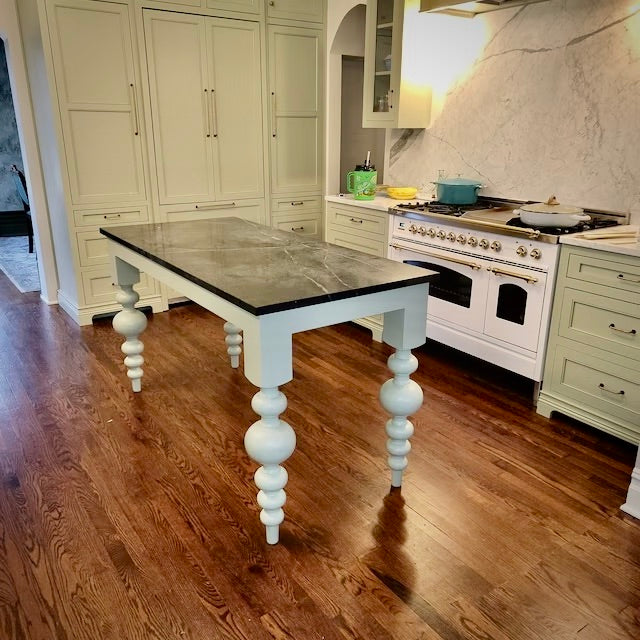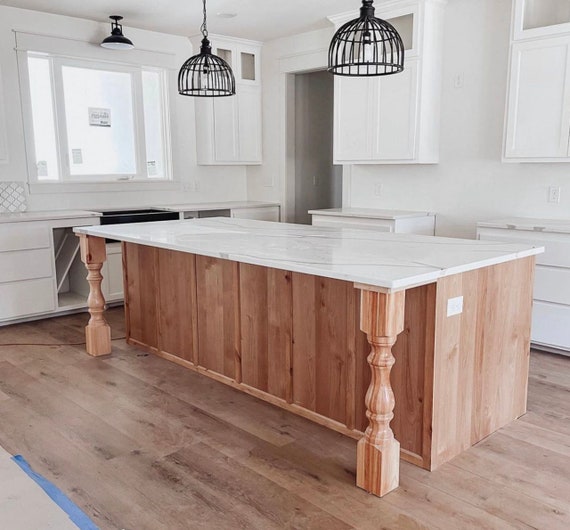Transform Your Area with Innovative Kitchen Island Leg Layouts
Transform Your Area with Innovative Kitchen Island Leg Layouts
Blog Article
Discovering the Vital Attributes of a Kitchen Area Island Leg for Your Culinary Space
The kitchen island serves as a main center in any culinary space, and the option of leg design is crucial in enhancing both its capability and aesthetic appeal. Understanding the crucial attributes of kitchen island legs-- including material choices, layout styles, and security variables-- can significantly affect the general experience within the kitchen.
Importance of Kitchen Island Legs
Kitchen island legs play a vital role in both the performance and aesthetics of a kitchen space. They not just support the weight of the island but also enhance the general design, contributing to the kitchen's aesthetic allure. The choice of legs can dictate the design of the kitchen, be it modern-day, traditional, or rustic.
Functionally, robust and effectively created legs guarantee stability, permitting the safe use of the island for numerous jobs such as food preparation, eating, or amusing. Solid legs protect against changing and wobbling, giving a trustworthy surface area for day-to-day tasks.
Additionally, the height and positioning of the legs can affect the convenience level for those seated at the island. A well-considered height can suit bar stools or chairs, advertising an inviting setting for gatherings.
In addition to these functional considerations, kitchen area island legs can act as a centerpiece in the space (kitchen island leg). Ornamental or distinctly created legs can elevate the layout visual, making the island a focal point. Therefore, picking the ideal kitchen area island legs is necessary for balancing type and feature in any type of culinary room
Product Options for Legs
Selecting the suitable product for kitchen area island legs substantially influences both sturdiness and style. Common material alternatives include wood, metal, and stone, each offering distinct advantages.
Timber is a prominent selection because of its heat and versatility. It can be conveniently tailored to match various style styles, from rustic to modern. Hardwoods like oak and maple provide excellent toughness and long life, while softer woods can be a lot more prone to tear and use.
Steel legs are favored for their streamlined, contemporary visual. kitchen island leg. Stainless steel and light weight aluminum are not just robust yet also immune to corrosion and corrosion, making them excellent for kitchen settings. They can create an industrial appearance and are frequently readily available in different coatings to complement other kitchen area components
Stone legs, such as granite or marble, add an aspect of deluxe and stability. While heavier than various other products, they offer phenomenal resilience and can stand up to substantial weight. However, they may need extra assistance to make certain proper balance.
Ultimately, the selection of material should straighten with both practical requirements and the total design vision of the cooking area area, ensuring that the island legs boost both utility and aesthetics.
Layout Styles to Take Into Consideration
What design styles should be taken into consideration when selecting legs for a cooking area island? The option of leg style substantially influences the total aesthetic of your cooking area. For a contemporary kitchen area, minimalistic and sleek leg styles, such as stainless steel or geometric forms, can improve the modern charm, offering a tidy and minimalist look.
In contrast, typical kitchen you can try this out areas take advantage of classic styles such as transformed or sculpted wooden legs, which include warmth and personality. These options commonly include elaborate details that complement vintage furnishings. For a rustic ambiance, consider legs made from redeemed wood or wrought iron, which bring an organic, earthy top quality to the room.
If you lean towards an industrial motif, robust steel legs with a distressed finish might be ideal, offering an edgy yet sophisticated touch. Furthermore, farmhouse design kitchen areas can integrate chunky legs that stimulate a feeling of toughness and homeliness.

Elevation and Stability Factors
The height and stability of a kitchen area island are vital components that directly influence its capability and user experience. A suitable kitchen island leg should offer adequate height to accommodate a selection of tasks, from food prep work to laid-back dining.
Stability is equally essential, specifically as kitchen islands frequently function as focal points in cooking environments. A steady leg layout reduces tottering and shifting, which can result in mishaps or pain during usage. Products such as strong timber, metal, or a combination thereof are generally utilized to attain the required sturdiness. The leg's accessory to the island's base have to be protected, making certain long life and durability against the wear and tear of daily usage.
Personalization and Accessories
Modification alternatives and accessories for kitchen island legs can dramatically improve both the aesthetic appeal and capability of the area. over here Property owners can pick from a selection of materials, consisting of metal, wood, and stone, enabling seamless assimilation with existing cooking area decoration. The option of coating-- be it a natural stain, paint, or powder coating-- further personalizes the appearance, guaranteeing that the island complements the general layout motif.
Along with material and finish, homeowners might likewise explore the consolidation of devices such as ornamental brackets, flexible feet, or integrated shelving. Braces can offer additional support while contributing to a modern-day or rustic visual. Flexible feet are specifically advantageous for uneven flooring, guaranteeing the island continues to be steady and level, find this which is crucial for both safety and security and functionality.

Verdict
To conclude, cooking area island legs offer a crucial role in giving stability and boosting the general aesthetic of the culinary space. The selection of materials and style styles contributes to both functionality and visual appeal, while considerations of elevation and stability ensure functional use. Personalization options and devices can boost the kitchen island, making it a distinct focal factor within the home. Hence, careful consideration of these features is important for a reliable cooking area layout.
The kitchen area island serves as a central hub in any type of culinary space, and the choice of leg style is crucial in boosting both its functionality and visual charm. Comprehending the necessary features of kitchen area island legs-- consisting of material alternatives, style styles, and security elements-- can dramatically impact the general experience within the kitchen.Kitchen area island legs play a vital role in both the performance and appearances of a kitchen room.What layout styles should be taken into consideration when picking legs for a kitchen island?In verdict, kitchen area island legs serve an essential role in offering security and improving the general aesthetic of the cooking area.
Report this page